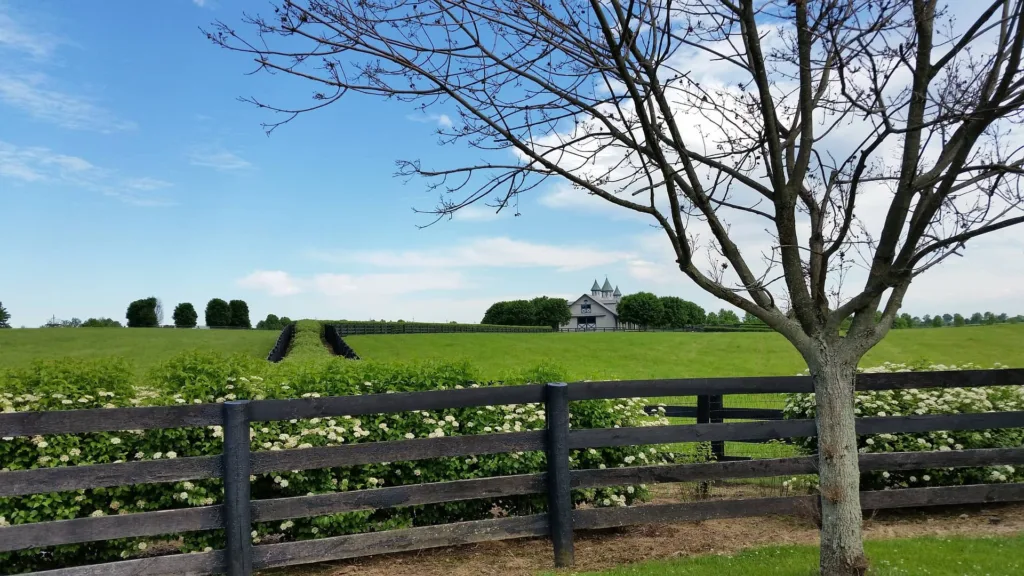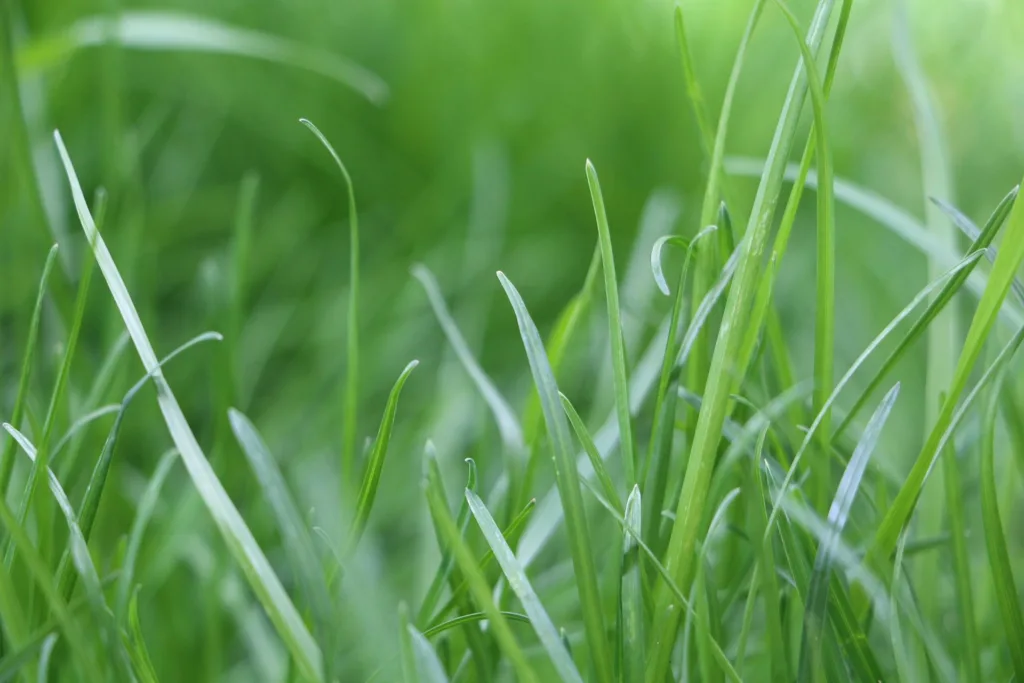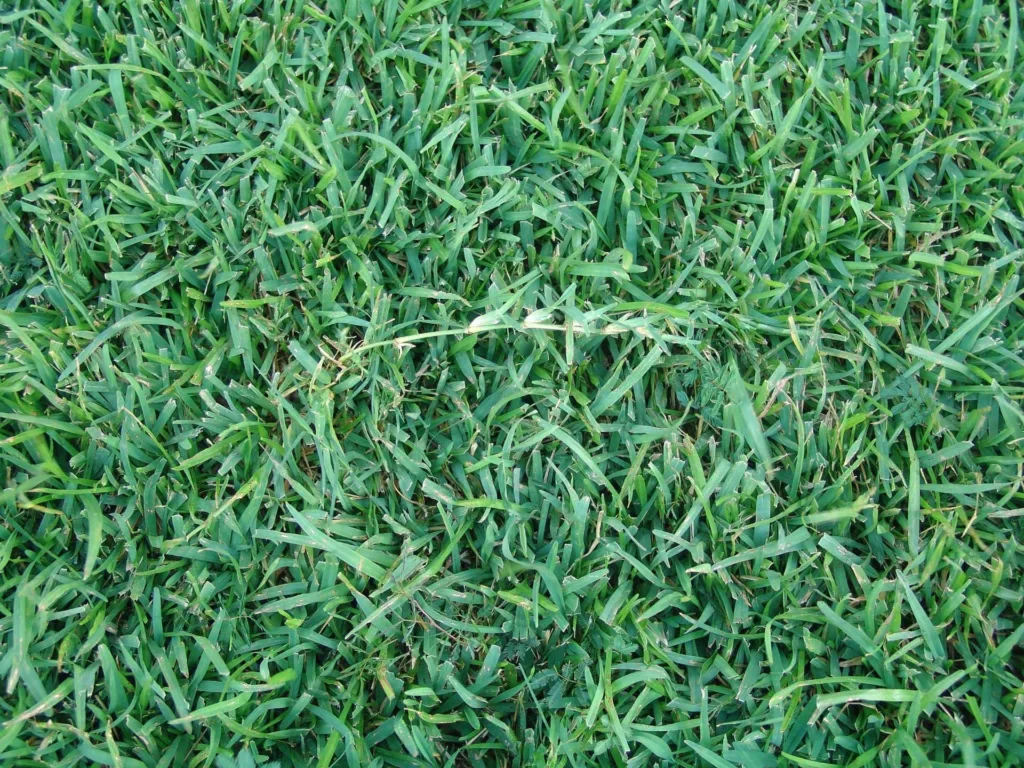Introduction: Unveiling the Magic of Kentucky Bluegrass
When it comes to creating a picture-perfect lawn, Kentucky Bluegrass stands out as the crown jewel of turfgrasses. This beloved grass variety has captivated homeowners, landscapers, and turf managers for generations, and for good reason. Kentucky Bluegrass (Poa pratensis) is renowned for its striking blue-green color, soft texture, and ability to create a dense, uniform carpet of green that’s both beautiful and resilient.
But what exactly is Kentucky Bluegrass, and why has it become such a popular choice for lawns across America? Let’s dive into the lush world of this remarkable grass and uncover its secrets.
What is Kentucky Bluegrass?
Kentucky Bluegrass is a cool-season perennial grass that’s native to Europe and parts of Asia. Despite its name, it didn’t originate in Kentucky, but it thrives so well in the Bluegrass State that it earned its moniker. This grass type is known for its:
- Vibrant blue-green color
- Fine texture
- Ability to form a dense, uniform turf
- Self-healing properties through underground rhizomes
- Excellent cold tolerance
A Brief History of Kentucky Bluegrass
The story of Kentucky Bluegrass in America is a testament to its adaptability and appeal. European settlers likely brought the grass to North America in the 17th or 18th century, either intentionally or as a stowaway in hay or animal bedding. It found an ideal home in the limestone-rich soils of Kentucky, where it flourished and eventually became synonymous with the region.
The Anatomy of Kentucky Bluegrass: Understanding Its Structure
To truly appreciate Kentucky Bluegrass, we need to look closer at its unique structure. Each part of this grass plays a crucial role in its overall performance and appearance.
Leaf Structure and Color
The leaves of Kentucky Bluegrass are what give it its distinctive appearance:
- Shape: Boat-shaped leaf tips, a key identifying feature
- Width: Typically 1/8 to 1/4 inch wide
- Length: Usually 2 to 6 inches long
- Texture: Fine and soft to the touch
- Color: A striking blue-green, due to a waxy coating on the leaves
This waxy coating serves a dual purpose: it gives the grass its signature color and helps it conserve water, making this grass type more drought-tolerant than it might otherwise be.
Root System
The root system of Kentucky Bluegrass is complex and efficient:
- Depth: Generally shallow to medium, typically reaching 2 to 6 inches deep
- Spread: In ideal conditions, roots can extend up to 2 feet
- Density: Forms a thick, intertwining network that helps prevent erosion
Growth Habits
One of the most remarkable features of Kentucky Bluegrass is its growth habit:
- Rhizomes: Underground stems that allow the grass to spread laterally
- Self-Healing: Can fill in bare spots on its own, creating a uniform lawn
- Growth Rate: Moderate, allowing for a dense turf without excessive mowing needs
This unique combination of features allows Kentucky Bluegrass to create a thick, lush lawn that can recover from wear and tear, making it ideal for high-traffic areas.
Growing Conditions for Kentucky Bluegrass: Creating the Perfect Environment
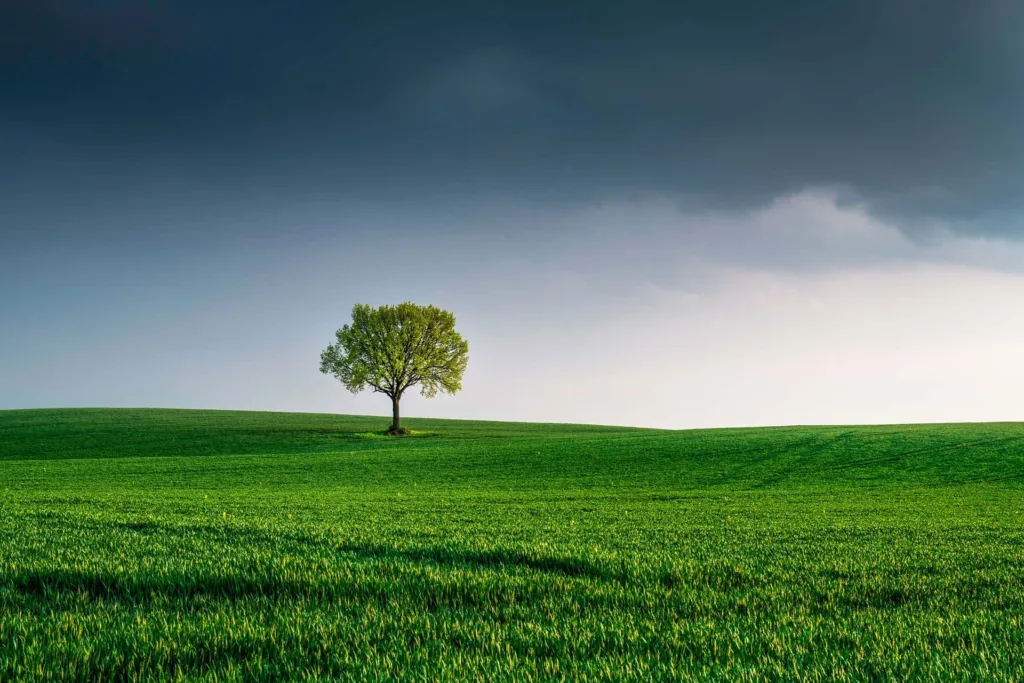
To thrive, Kentucky Bluegrass needs specific environmental conditions. Understanding these requirements is key to growing a healthy, vibrant lawn.
Climate Requirements
Kentucky Bluegrass is best suited for cool, humid climates:
- Optimal Growth Temperature: 60-75°F (15-24°C)
- Cold Tolerance: Excellent, can survive harsh winters
- Heat Tolerance: Moderate, may struggle in prolonged high temperatures
Soil Preferences
The right soil conditions are crucial for Kentucky Bluegrass:
- pH Level: Prefers slightly acidic to neutral soil (pH 6.0-7.0)
- Soil Type: Well-draining, fertile soils are ideal
- Compaction: Avoid heavily compacted soils, as they restrict root growth
Sunlight Needs
Kentucky Bluegrass is a sun-loving grass:
- Ideal: Full sun (6+ hours of direct sunlight daily)
- Tolerance: Can handle light shade, but performance may decrease
- Shade Issues: In heavy shade, the grass may thin out or die off
Water Requirements
Proper watering is essential for a healthy Kentucky Bluegrass lawn:
- Amount: Typically needs 1-1.5 inches of water per week
- Frequency: Prefers deep, infrequent watering over light, frequent watering
- Timing: Early morning watering is best to reduce evaporation and disease risk
Planting Kentucky Bluegrass: From Seed to Lush Lawn
Ready to start your Kentucky Bluegrass lawn? Follow this comprehensive guide to ensure success.
Best Time to Plant
Timing is crucial when planting Kentucky Bluegrass:
- Fall Planting: The ideal time, typically 6-8 weeks before the first frost
- Spring Planting: Possible, but less ideal due to summer heat stress
- Avoid: Late spring and summer planting, which can lead to poor establishment
Seed Selection Tips
Choosing the right seed is the first step to a beautiful lawn:
- Look for certified seed to ensure quality and purity
- Consider blends of different Kentucky Bluegrass varieties for improved performance
- Check for disease resistance, especially if you live in a humid area
- Consider newer cultivars that may offer improved drought or shade tolerance
Step-by-Step Planting Guide
Follow these steps for successful Kentucky Bluegrass planting:
- Soil Preparation:
- Test soil pH and amend if necessary
- Remove debris and loosen the top 2-3 inches of soil
- Add organic matter if soil is poor
- Seeding:
- Use 2-3 pounds of seed per 1,000 square feet
- Spread seed evenly using a broadcast spreader
- Lightly rake to cover seeds with 1/8 inch of soil
- Watering:
- Keep the soil consistently moist until germination (7-14 days)
- Water lightly and frequently, about 3-4 times daily
- Post-Germination Care:
- Reduce watering frequency but increase amount as grass establishes
- Begin mowing when grass reaches about 3 inches tall
Overseeding Existing Lawns
To rejuvenate an existing lawn with Kentucky Bluegrass:
- Mow the existing lawn short and remove clippings
- Aerate or dethatch to improve seed-to-soil contact
- Spread seed at half the rate used for new lawns
- Keep the area moist until new grass establishes
- Avoid heavy traffic on the newly seeded areas
Maintaining a Kentucky Bluegrass Lawn: The Key to Long-Term Beauty
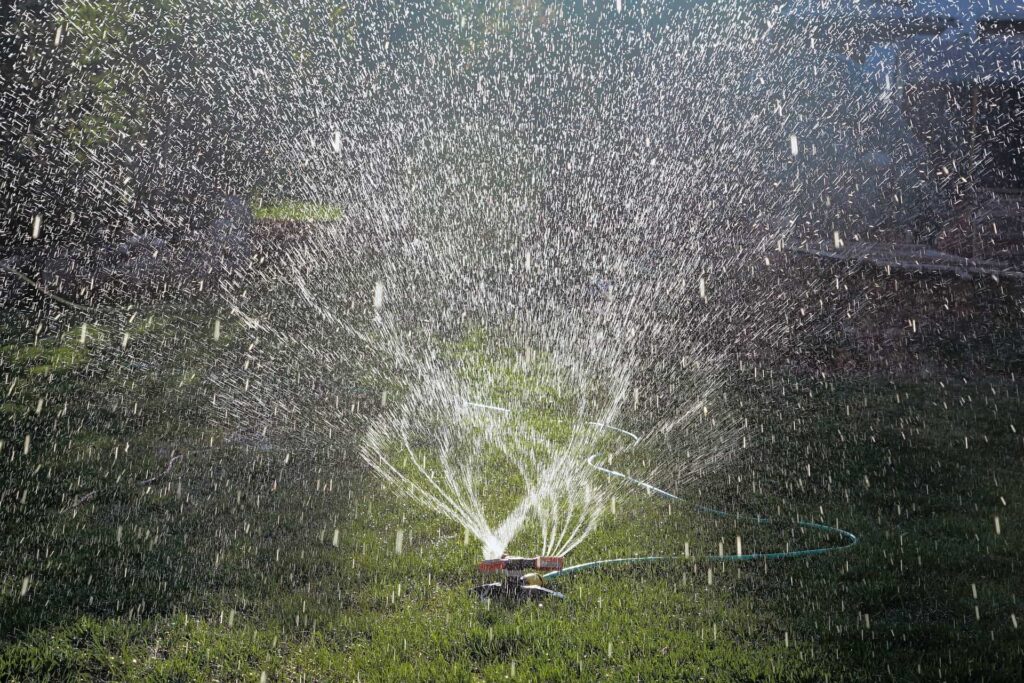
A beautiful lawn requires consistent care. Here’s a comprehensive maintenance guide to keep your lawn lush and healthy.
Mowing Techniques and Frequency
Proper mowing is crucial for a healthy lawn:
- Height: Keep your lawn at 2.5-3.5 inches tall
- Frequency: Mow often enough that you’re never removing more than 1/3 of the grass blade
- Technique: Use sharp blades and alternate mowing patterns
- Clippings: Leave them on the lawn to recycle nutrients, unless they’re excessively long
Fertilization Schedule
Kentucky Bluegrass is a heavy feeder. Follow this annual fertilization schedule:
| Season | Fertilizer Type | Purpose |
|---|---|---|
| Early Spring | Balanced (e.g., 16-4-8) | Promote green-up |
| Late Spring | Slow-release nitrogen | Sustain growth |
| Early Fall | High nitrogen | Promote root growth |
| Late Fall | Winterizer (high potassium) | Prepare for winter |
Watering Practices
Efficient watering is key to a healthy Kentucky Bluegrass lawn:
- Water deeply and infrequently, providing about 1-1.5 inches per week
- Water early in the morning to reduce evaporation and fungal growth
- During hot, dry periods, increase watering frequency but maintain the same weekly total
- Use a rain gauge or sprinkler gauge to measure water output
Aeration and Dethatching
These practices help maintain soil health and grass vigor:
- Aeration: Perform annually in the fall to reduce soil compaction
- Dethatching: Remove thatch when it exceeds 1/2 inch thick, typically every 2-3 years
- Timing: Perform these tasks when the grass is actively growing for quicker recovery
Common Problems and Solutions: Troubleshooting Your Kentucky Bluegrass Lawn

Even well-maintained Kentucky Bluegrass lawns can face challenges. Here’s how to identify and address common issues:
Pests That Affect Kentucky Bluegrass
- Grubs:
- Signs: Brown patches that peel up easily
- Solution: Apply beneficial nematodes or use a targeted insecticide
- Chinch Bugs:
- Signs: Yellowing patches that turn brown and die
- Solution: Maintain proper watering and consider using insecticidal soap
- Sod Webworms:
- Signs: Brown patches and chewed grass blades
- Solution: Use Bacillus thuringiensis (Bt) or other biological controls
Diseases to Watch Out For
- Dollar Spot:
- Signs: Small, circular dead patches
- Solution: Improve air circulation and avoid overwatering
- Fusarium:
- Signs: Circular patches with a frosted appearance
- Solution: Reduce nitrogen fertilization and improve drainage
- Leaf Spot:
- Signs: Small, dark spots on grass blades
- Solution: Avoid excessive nitrogen and water in early spring
Weed Control Strategies
Effective weed management is crucial for a pristine Kentucky Bluegrass lawn:
- Prevention:
- Maintain a dense, healthy turf to outcompete weeds
- Use pre-emergent herbicides in early spring
- Spot Treatment:
- For established weeds, use selective post-emergent herbicides
- Hand-pull isolated weeds when possible
- Cultural Practices:
- Proper mowing height and frequency can discourage weed growth
- Avoid overwatering, which can create favorable conditions for weeds
Dealing with Shade and Heat Stress
Kentucky Bluegrass can struggle in extreme conditions:
- Shade Management:
- Prune trees to allow more sunlight
- Overseed with shade-tolerant grass varieties
- Reduce traffic in shaded areas
- Heat Stress Mitigation:
- Raise mowing height during hot periods
- Water deeply and early in the morning
- Avoid unnecessary traffic on stressed lawns
Kentucky Bluegrass Varieties: Choosing the Right Cultivar
Not all Kentucky Bluegrass is created equal. Here’s a guide to some popular cultivars and their unique traits:
Popular Cultivars
- Midnight: Dark green color, excellent disease resistance
- Everest: High drought tolerance, good shade performance
- Prosperity: Rapid establishment, good wear tolerance
- Avalanche: Fine texture, excellent winter color
Comparing Traits
When selecting a particular variety, consider these key traits:
| Trait | Importance | Examples |
|---|---|---|
| Color | Aesthetic appeal | Midnight (dark green), Everest (medium-dark green) |
| Texture | Feel and appearance | Avalanche (fine), Prosperity (medium-fine) |
| Disease Resistance | Reduced maintenance | Midnight (high), Everest (moderate) |
| Drought Tolerance | Water efficiency | Everest (high), Prosperity (moderate) |
| Shade Tolerance | Versatility | Everest (good), Midnight (moderate) |
Choosing the Right Variety for Your Lawn
Consider these factors when selecting your Kentucky Bluegrass variety:
- Local climate and typical weather patterns
- Soil type and quality in your yard
- Amount of shade in your lawn area
- Intended use (e.g., high traffic, purely aesthetic)
- Maintenance level you’re willing to commit to
Kentucky Bluegrass vs. Other Grass Types: Making the Right Choice
While Kentucky Bluegrass is popular, it’s essential to understand how it compares to other grass types:
Pros and Cons of Kentucky Bluegrass
Pros:
- Beautiful blue-green color
- Soft, fine texture
- Self-healing through rhizomes
- Excellent cold tolerance
Cons:
- High maintenance requirements
- Poor shade tolerance
- Moderate drought tolerance
Comparisons with Other Grass Types
| Grass Type | Pros | Cons | Best Use |
|---|---|---|---|
| Kentucky Bluegrass | Beautiful color, self-healing | High maintenance, poor shade tolerance | Full-sun lawns in cool climates |
| Tall Fescue | Drought-resistant, wear-tolerant | Coarser texture, doesn’t spread | Low-maintenance lawns, transitional zones |
| Perennial Ryegrass | Quick germination, good wear tolerance | Poor cold tolerance, high maintenance | Overseeding, sports fields |
| Bermuda | Heat-tolerant, low water needs | Invasive, poor cold tolerance | Warm-climate lawns, golf courses |
Mixed Seed Blends: When and Why to Use Them
Mixing Kentucky Bluegrass with other grass types, such as fine fescue, can offer several benefits:
- Kentucky Bluegrass + Perennial Ryegrass:
- Quick establishment with long-term quality
- Good for overseeding or starting new lawns
- Kentucky Bluegrass + Fine Fescue:
- Improved shade tolerance
- Reduced water and fertilizer needs
- Kentucky Bluegrass + Tall Fescue:
- Enhanced drought tolerance
- Improved wear resistance
Consider a mixed blend if you have varied conditions in your lawn or want to balance Kentucky Bluegrass’s high maintenance needs with more resilient varieties.
Kentucky Bluegrass Beyond Lawns: Versatility in Landscaping
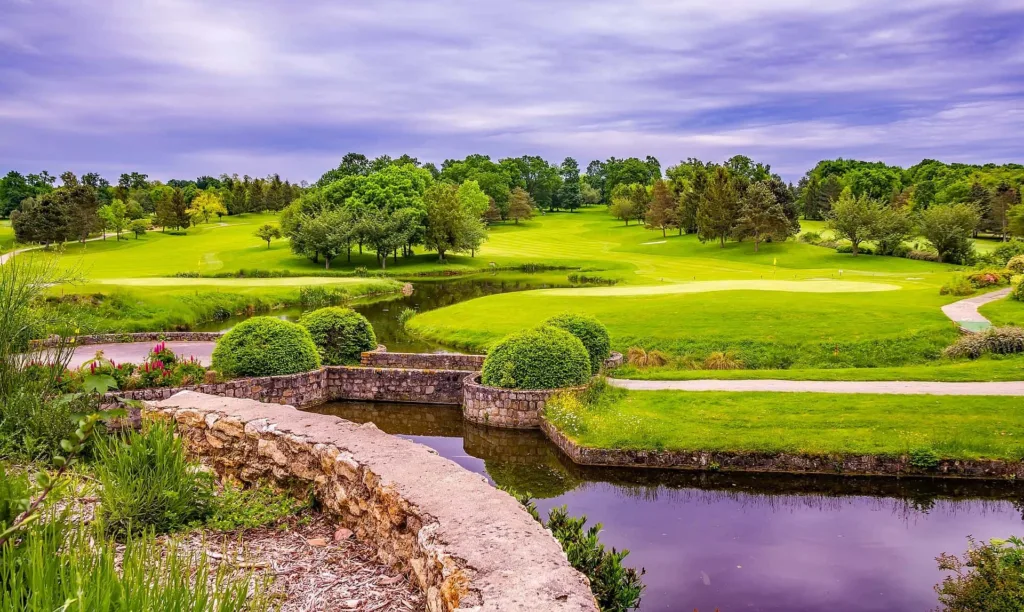
While Kentucky Bluegrass is a favorite for residential lawns, its uses extend far beyond the average backyard:
Use in Sports Fields and Golf Courses
Kentucky Bluegrass is a top choice for many athletic surfaces:
- Football Fields: Offers excellent wear tolerance and recovery
- Soccer Pitches: Provides a uniform playing surface
- Golf Course Fairways: Creates a lush, manicured appearance
- Baseball Outfields: Stands up well to heavy traffic
The grass’s ability to self-repair through its rhizomatous growth makes it ideal for high-use areas. Its dense growth also provides good footing for athletes.
Ornamental Applications
Kentucky Bluegrass isn’t just functional; it can be a beautiful design element:
- Formal Gardens: Creates a lush, uniform backdrop for flower beds and statuary
- Green Roofs: When mixed with drought-tolerant species, can be used in some green roof applications
- Living Sculptures: Can be molded and shaped into living art pieces
- Borders: Provides a clean edge along pathways or driveways
Erosion Control Benefits
It’s dense root system of makes it an excellent choice for erosion control:
- Steep Slopes: Can help stabilize hillsides when properly established
- Waterways: Often used along drainage ditches to prevent soil loss
- Construction Sites: Quickly establishes to prevent soil erosion during and after construction
Environmental Considerations: Balancing Beauty and Sustainability
While Kentucky Bluegrass offers many benefits, it’s important to consider its environmental impact and explore ways to maintain it responsibly.
Water Usage and Conservation Techniques
Kentucky Bluegrass has high water requirements, but there are ways to reduce water use:
- Efficient Irrigation: Use smart controllers and drip irrigation where possible
- Rainwater Harvesting: Collect and use rainwater for irrigation
- Proper Mowing Height: Keeping grass longer encourages deeper roots and better drought tolerance
- Soil Improvement: Add organic matter to increase water retention
Eco-Friendly Maintenance Practices
Maintaining a Kentucky Bluegrass lawn doesn’t have to come at the expense of the environment. Here are some sustainable practices:
- Organic Fertilizers: Use compost or other organic fertilizers to reduce chemical runoff
- Integrated Pest Management (IPM): Adopt a holistic approach to pest control, using chemicals only as a last resort
- Electric or Manual Equipment: Replace gas-powered tools with electric or manual alternatives to reduce emissions
- Grasscycling: Leave grass clippings on the lawn to recycle nutrients and reduce waste
- Native Plant Borders: Incorporate native plants around your lawn to support local ecosystems
Native Alternatives to Kentucky Bluegrass
In some regions, native grasses might be a more sustainable choice:
- Buffalo Grass: A warm-season grass native to the Great Plains, requiring less water and maintenance
- Pennsylvania Sedge: A cool-season grass-like plant that tolerates shade and requires little mowing
- Blue Grama: Another warm-season grass native to North America, known for its drought tolerance
Consider mixing with these natives for a more diverse and resilient lawn.
Expert Tips for a Thriving Kentucky Bluegrass Lawn
To take your Kentucky Bluegrass lawn to the next level, consider these advanced techniques and seasonal care tips.
Seasonal Care Guide
Spring:
- Conduct a soil test and amend as necessary
- Apply pre-emergent herbicide to prevent crabgrass
- Begin regular mowing as grass starts actively growing
- Overseed bare patches
Summer:
- Raise mowing height to reduce heat stress
- Water deeply and infrequently to encourage deep root growth
- Monitor for pest activity and address promptly
- Avoid heavy traffic on stressed areas
Fall:
- Aerate and overseed if needed
- Apply fall fertilizer to promote root growth
- Continue mowing until grass stops growing
- Clean up fallen leaves to prevent smothering
Winter:
- Avoid walking on frozen grass to prevent damage
- Plan for next year’s lawn care strategy
- Maintain equipment for the upcoming season
Troubleshooting Common Issues
- Patchy Growth:
- Cause: Poor soil, inadequate water, or pest damage
- Solution: Address underlying issues and overseed affected areas
- Yellowing Grass:
- Cause: Nutrient deficiency, overwatering, or disease
- Solution: Adjust fertilization and watering practices, treat for diseases if present
- Thinning Turf:
- Cause: Shade, compaction, or heavy traffic
- Solution: Prune trees for more light, aerate soil, and redirect traffic
Advanced Maintenance Techniques
- Soil Profiling: Regularly test and analyze your soil composition to tailor your fertilization program
- Growth Regulators: Use plant growth regulators to reduce mowing frequency and improve turf density
- Precision Irrigation: Implement a smart irrigation system that adjusts watering based on weather conditions
- Microbial Inoculants: Introduce beneficial soil microbes to improve nutrient uptake and stress tolerance
Conclusion: Embracing the Beauty of Kentucky Bluegrass
As we’ve explored throughout this guide, Kentucky Bluegrass offers a unique combination of beauty, resilience, and versatility that’s hard to match. Its lush, blue-green color and soft texture create a lawn that’s not just visually stunning but also a joy to experience.
Recap of Kentucky Bluegrass Benefits
- Aesthetic Appeal: Unmatched color and texture
- Durability: Self-healing properties through rhizomatous growth
- Versatility: Suitable for various applications beyond residential lawns
- Cold Tolerance: Excellent performance in cool climates
Final Thoughts on Creating the Perfect Lawn
Creating and maintaining a Kentucky Bluegrass lawn is both an art and a science. It requires dedication, knowledge, and a willingness to work with nature. While it may demand more attention than some other grass types, the results are well worth the effort.
Remember that a perfect lawn doesn’t mean a uniform, weed-free monoculture. A truly healthy lawn is one that’s resilient, diverse, and in harmony with its environment. Consider incorporating native plants, embracing some diversity in your turf, and adopting sustainable practices to create a lawn that’s not just beautiful, but also beneficial to the ecosystem.
Encouragement for Readers to Start Their Kentucky Bluegrass Journey
Whether you’re starting from scratch or looking to improve an existing lawn, the journey to a beautiful Kentucky Bluegrass lawn is rewarding. Each season brings new challenges and opportunities, allowing you to continually learn and refine your approach.
Don’t be discouraged by setbacks – even experienced lawn care enthusiasts face challenges. View each problem as an opportunity to deepen your understanding and improve your techniques. With patience, persistence, and the knowledge you’ve gained from this guide, you’re well-equipped to create a lawn that’s the envy of the neighborhood.
So roll up your sleeves, grab your gardening tools, and step out onto your lawn. Your Kentucky Bluegrass journey starts now, and a world of lush, green beauty awaits. Happy gardening!
